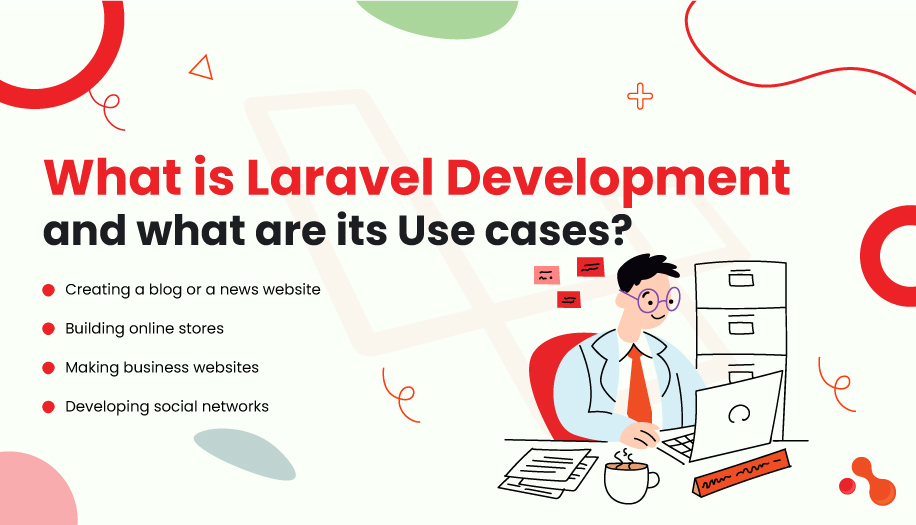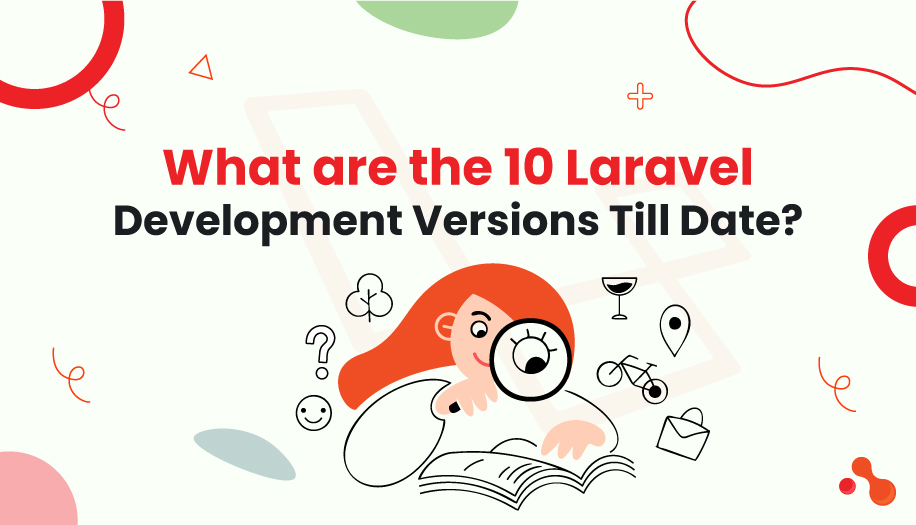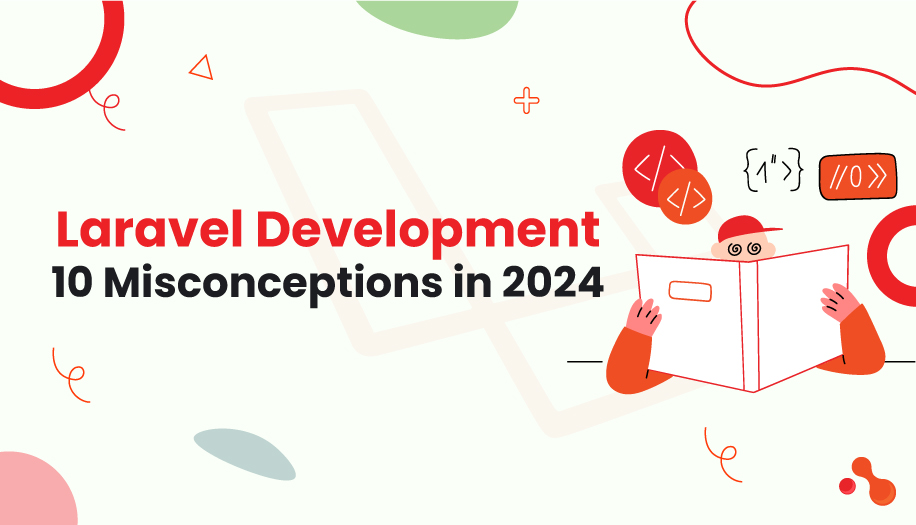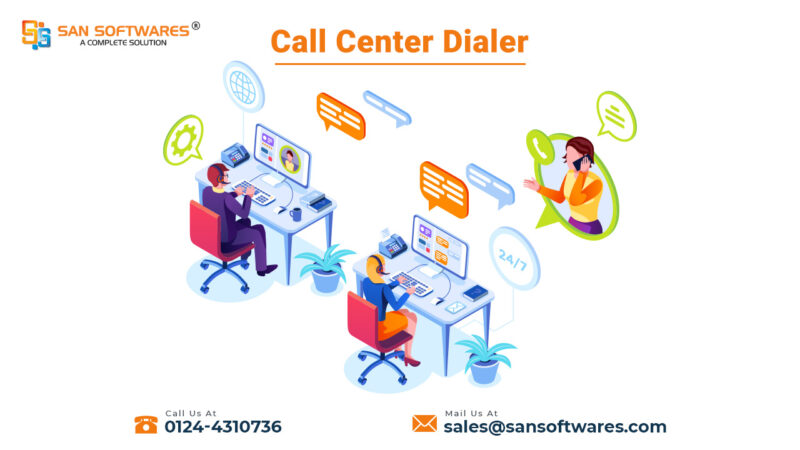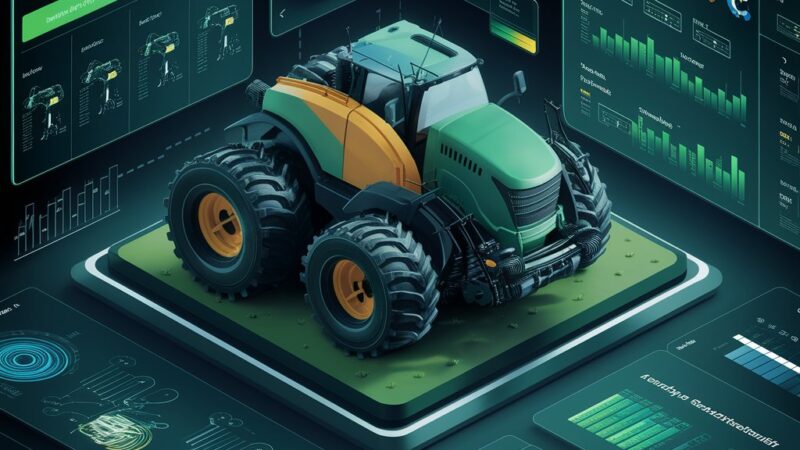Laravel Development: 10 Misconceptions You Must Know About!

Introduction
Since it started, Laravel has been a leading tool for building websites using PHP, known for its beautiful way of writing code, strong features, and solid base for creating web applications. But as technology moves fast and ways of making websites change, there are some wrong ideas about Laravel that people have.
These might come from old information, unfair comparisons with other tools, or from misunderstandings about what Laravel can and cannot do. This article aims to clear up ten common wrong beliefs about using Laravel for web development in 2024, showing how it really is a great tool for making websites today.
But before discussing the misconceptions let’s first understand what Laravel Development is and what are some of its use cases.
What is Laravel Development and what are its Use cases?
Laravel Development is like using a big box of building blocks to make websites and web applications. Think of it as a toolkit that helps developers create things on the internet more easily. It gives them a set of rules and tools so they can build more complex websites faster and with fewer problems. Laravel is especially good because it makes the code look clean and easy to understand, and it comes with a lot of features that handle common tasks right out of the box.
Some things you might use Laravel for include:
- Creating a blog or a news website: It helps you manage posts, categories, and comments easily.
- Building online stores: Laravel can handle product listings, shopping carts, and payments.
- Making business websites: You can create pages to show off your services, handle customer inquiries through forms, and even manage user accounts.
- Developing social networks: It’s capable of handling user profiles, friend connections, posts, and messages.
- Setting up forums or discussion boards: Laravel helps in organizing threads, replies, and user management.
In short, Laravel is like a Swiss Army knife for web developers – it has a tool for almost every need when it comes to building websites or online applications.
Now, let’s briefly understand different versions of Laravel launched till date.
What are the 10 Laravel Development Versions Till Date?
Here’s a brief overview of major Laravel versions, highlighting their key features or improvements. Note that Laravel’s evolution reflects ongoing efforts to make web development more efficient, secure, and feature-rich.
Laravel 1
Released: 2011
Introduced Laravel to the world with built-in support for authentication, localization, models, views, sessions, routing, and other fundamental web development features.
Laravel 2
Released: 2011
Added support for controllers, essentially moving Laravel towards a more robust MVC architecture.
Laravel 3
Released: 2012
Brought major features like the Command Line Interface (CLI) named Artisan, migrations for database management, and support for database system layers.
Laravel 4
Released: 2013
Known as “Illuminate,” it was a complete rewrite of the framework, introducing Composer for package management, queuing services, and better routing capabilities.
Laravel 5
Released:2015
Featured a new directory structure, improved method injection, and multiple filesystems. It also introduced Laravel Elixir for asset management and the Contracts package for core services.
Laravel 6
Released: 2019
Shifted to Semantic Versioning, focusing on better code reliability and maintenance. Laravel 6 is considered a LTS (Long Term Support) version, highlighting improved authorization responses, job middleware, and lazy collections.
Laravel 7
Released: 2020
Introduced Laravel Airlock (later renamed Sanctum), a package for SPA (Single Page Application) authentication, custom Eloquent casts, HTTP client, and Blade component tags.
Laravel 8
Released: 2020
Added features like Laravel Jetstream for application scaffolding, model factory classes, job batching, rate limiting improvements, and dynamic Blade components.
Laravel 9
Released: 2022
The first to shift to a yearly release cycle. It introduced Symfony Mailer, Flysystem 3.x, improved route caching, and new query builder interfaces.
Laravel 10
Released: 2023
Introduced type annotations for cleaner code, the Process facade for managing external processes, and Laravel Pennant for feature flag management. Enhanced testing with a –profile option for Artisan and optional Pest framework support. Improved user experience with updated generator commands and redesigned Horizon and Telescope UIs.
Each version of Laravel builds upon the last, constantly adding new features and improvements to support modern web development practices.
Read Laravel Development: A Walkthrough in 2024 – Part 1 to learn about each version in detail.
Now, let’s understand all the misconceptions circling around Laravel Development even in 2024.
Laravel Development: 10 Misconceptions in 2024
Misconception 1: Laravel is Only for Small Projects
The Myth: A common misunderstanding is that Laravel is tailored exclusively for small to medium-sized projects, lacking the capacity to scale.
The Reality: Laravel’s architecture is designed to accommodate applications of any size, from small startups to large-scale enterprise solutions. With features like queue management, event broadcasting, and scalable file storage capabilities, Laravel can efficiently handle high traffic and complex application requirements. The framework has seen numerous updates by 2024, each enhancing its ability to serve larger and more demanding applications, debunking any notions of its supposed small-scale limitations.
Misconception 2: Laravel’s Performance is Subpar
The Myth: Critics often claim Laravel sacrifices performance for developer convenience and elegance.
The Reality: While no framework can claim absolute supremacy in performance, Laravel offers a highly optimized foundation that, when leveraged correctly, can meet stringent performance criteria. Techniques such as route caching, optimized database queries through Eloquent, and efficient memory use contribute to Laravel’s ability to serve applications quickly. The introduction of JIT compilers and improvements in PHP itself have further narrowed the performance gaps, making Laravel a competitive choice for developers prioritizing speed and efficiency in 2024.
Misconception 3: Laravel is Not Secure
The Myth: Some believe Laravel is inherently less secure than other frameworks or languages.
The Reality: Security is a paramount concern for the Laravel team, evident in its built-in features like XSS protection, encryption, CSRF tokens, and SQL injection prevention. The framework adheres to industry best practices and is regularly updated to address new vulnerabilities. By 2024, Laravel has further solidified its security posture, incorporating cutting-edge security features that safeguard applications against emerging threats.
Misconception 4: Laravel Lacks Community Support
The Myth: A less prevalent but still present misconception is that Laravel lacks a strong community or support system.
The Reality: Laravel boasts one of the most vibrant and supportive communities in the web development world. With an extensive ecosystem of tutorials, forums, podcasts, and third-party packages, developers can easily find guidance and resources. The Laravel ecosystem has only grown by 2024, further enhancing the support available to developers at all skill levels.
Misconception 5: Laravel is Difficult to Learn
The Myth: The perception that Laravel is hard to learn can deter newcomers.
The Reality: Laravel is praised for its comprehensive and well-written documentation, which facilitates a smooth learning curve. The framework’s design principles are grounded in simplicity and readability, making it accessible to developers new to PHP or web development. By 2024, the availability of educational platforms, video tutorials, and interactive learning resources has made mastering Laravel more attainable than ever.
Misconception 6: Laravel Doesn’t Support Modern Front-End Development
The Myth: Some assert that Laravel is not suited for modern front-end development practices.
The Reality: Laravel seamlessly integrates with modern front-end tools and libraries, including Vue.js, React, and Angular. Laravel Mix, an elegant API for defining Webpack build steps, simplifies the management of assets, compiling of JavaScript, and pre-processing of CSS. This integration has evolved, reflecting the latest trends and technologies in front-end development by 2024.
Misconception 7: Laravel is Not Suitable for APIs
The Myth: Another misconception is that Laravel falls short when it comes to building APIs.
The Reality: Laravel excels in API development, offering a suite of tools designed for this purpose, including API resource classes and the Laravel Passport package for OAuth2 implementation. These tools simplify the creation of robust, scalable APIs, a capability that Laravel has continued to refine and expand upon up to 2024.
Misconception 8: Laravel’s ORM is Overkill
The Myth: Critics sometimes claim that Eloquent, Laravel’s ORM, is overly complex or unnecessary.
The Reality: Eloquent provides an active record implementation that simplifies database interactions, making code more readable and maintainable. It’s designed to strike a balance between functionality and simplicity, offering advanced features without imposing them on developers. Over the years, Eloquent has been optimized for performance and usability, proving its worth in a wide range of applications by 2024.
Misconception 9: Laravel Updates Break Applications
The Myth: There’s a fear that updating Laravel can break applications due to compatibility issues.
The Reality: Laravel is committed to ensuring a smooth upgrade process, adhering to semantic versioning and providing extensive upgrade guides. Tools like Laravel Shift automate the upgrade process, minimizing the risk of breaking changes. By 2024, the framework’s upgrade paths have become even more refined, making it easier for developers to keep their applications up-to-date.
Misconception 10: Laravel is Losing Popularity
The Myth: Some speculate that Laravel is on the decline in terms of popularity and relevance.
The Reality: Laravel continues to be one of the most popular and actively developed PHP frameworks, with a growing user base and ecosystem. Its adaptability to evolving web development practices, along with a strong community and ecosystem, ensures its place as a preferred framework among developers. In 2024, Laravel remains at the cutting edge of web application development, challenging the notion of its supposed decline.
Wrapping Up!
Misconceptions regarding Laravel must be debunked in order for developers to properly comprehend and utilize the framework’s potential. As seen, Laravel is a strong, scalable, and secure framework that caters to a wide range of web development requirements, from API generation to current front-end integration.
Its continual evolution, strong community support, and vast resources make it an appealing option for developers in 2024 and beyond. Understanding the truth underlying these frequent myths can help developers use Laravel more successfully to create efficient, scalable, and complex online apps.
Read More Interesting Articles on Mirror Eternally

